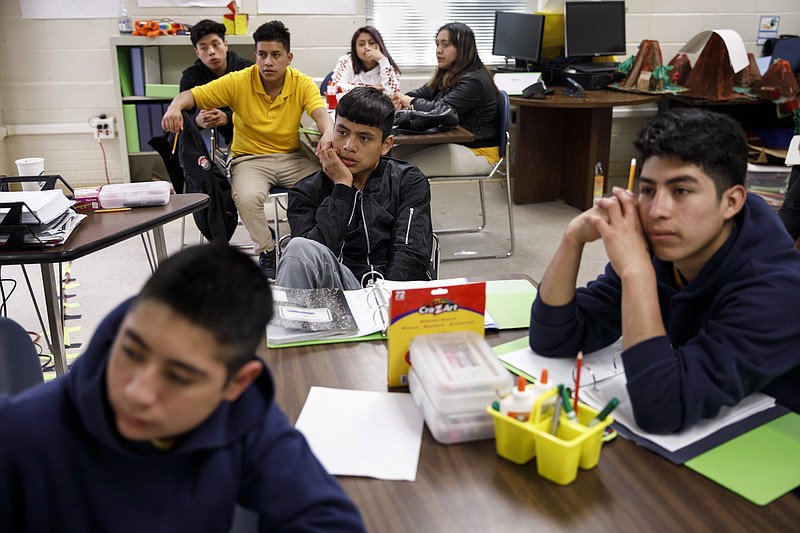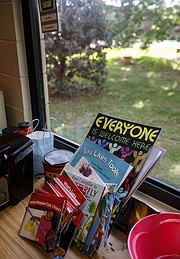Originally from Guatemala City, the capitol of Guatemala, Militza came to the U.S. this spring to join her parents, who had already been living here for four years.
Militza speaks almost no English, but she sits in a classroom at The Howard School. She is determined to get a high school diploma and one day return to Guatemala, she told the Times Free Press with the help of an interpreter.
One of her classmates, Mycol, 17, speaks better English than her. He lives with an older brother and works after school and on weekends, like Militza, while also attending school and attempting to succeed, despite a huge language barrier and his previous lack of formal education.
Mycol came to the U.S. "to work and study," he said slowly. He spent several months in an ICE detention center on his journey from Guatemala to his new home. He misses his parents.
Militza and Mycol are illustrative of the changing demographics at The Howard School. The student population of the once predominantly African American school is now about 48% Latino, and that number is on the rise.
Of the about 500 Latino/Hispanic students at the school, about 330 are English-language learners.
Many of them are new to the country, have little formal education and don't speak the language. Many are also undocumented, which is why students in this story are only being identified by their first names.
A new program, launched at Howard this year, is aimed at supporting these "newcomers" like Militza and Mycol.
The NewComer Academy is the first program of its type in Hamilton County Schools. It is aimed at supporting these students by immersing them in intense English language classes through small classes with other students who are new to the country.
School officials hope it will help students like Militza and Mycol transition into their new lives, help them navigate the many cultural and language barriers and help them find success.
Raising Mayan children
It was Amilcar's birthday and his teacher, Emily Guyer - one of the two who helped launch the NewComer Academy this spring - passed out cupcakes to him and his peers.
His classmates sang bits of the "Happy Birthday" song, another one followed up with his own Spanish version. Most of the students in class are males. In fact, of Howard's 508 Hispanic students, more than 66% of them are males, and the ratio is similar within the two NewComer classrooms.
Guyer speaks to the students in a mix of English and Spanish, sometimes delivering instructions in both, though NewComer lessons are taught predominantly in English.
"You have to put yourself out there to learn a new language," Guyer said. "Here is when they can really take the opportunity to try and speak English because everyone else is learning, as well."
Words of encouragement or important messages are often given in Spanish to avoid confusion and provide some comfort to the students.
This spring, 37 students have participated in Howard's pilot NewComer Academy, said Anjelika Riano, the district's coordinator of the newcomer program. Spread between two classrooms, this is a high number for language learning, Riano said. Research suggests that ratios of one teacher to 10-12 students is actually ideal.
Many of the students in the program have lived in the U.S. for less than a year. Though they may speak Spanish, for many it's a second or third language. Most students speak a variety of Guatemalan and Mayan dialects, such as Q'anjob'al, K'iche, Mam and Akateko. Some cannot read or write in Spanish - or at all.
"It's a very unique situation," Riano said. "Most people in Chattanooga probably don't realize we are raising Mayan children."
Hamilton County Schools Chief Equity Officer Marsha Drake said the program was created in response to the dramatic increase in numbers of those students.
"We saw an overwhelming number of students who arrive to attend school in America for the very first time," Drake said. "The overwhelming number of students who are doing just that are high-school-aged students, so we want to make sure that we provide them with an environment where they are around typically developing peers and they are immersed in the English language."
Riano said the program is designed to support students in Spanish or their native languages, but not to teach in Spanish. Students travel together through core courses throughout the day, but interact with their peers at Howard during electives such as physical education, related arts and personal finance. They see other students in the hallways, at lunch and they live in the same neighborhoods.
"The NewComer Center allow[s] us to immerse them into that language acquisition before thrusting them into those required courses and assessments that [they] have to take as Tennessee students," Howard Principal Le Andrea Ware recently told the Hamilton County Commission.
The center is housed at Howard because that is where the district has seen the largest increase in non-English-speaking students, Drake said. But East Ridge and Red Bank are also seeing a growing population of immigrant students.
Of the district's almost 45,000 students, there were 5,249 English language learners this year, according to district data.
"I like to call the challenges at Howard 'complex opportunities,' because we do have some very difficult circumstances that we deal with," Ware said. "But I tell our teachers, I tell our leaders at our school [that] we have to believe in our students before they believe in themselves."
Living adult lives
In the coming school year, the district hopes to expand the NewComer Academy.
In Superintendent Bryan Johnson's proposed budget for fiscal year 2020, there are two additional English as a Second Language teachers and a NewComer Academy coordinator included.
Drake said a wing of the newly renovated and reopened Howard Connect Academy, formerly Howard Middle School, will be devoted to the program.
"Our vision really is for the program to grow and that we have a mini-wing so that we can actually serve more than just the students academically, so we can support the whole child," Drake said. "We plan to have a family resource center and offer different services that the families need in order to be successful."
Stacey Johnson, executive director and CEO of La Paz Chattanooga, the largest nonprofit focused on serving Latinos in Chattanooga, said the idea of such a program had been in discussion for several years within the community, especially the one La Paz serves here in Chattanooga.
"We are thrilled to know it is now a reality," she said. "We hope to establish ways to engage the community in the Newcomer Academy. We are confident that the families we serve will benefit tremendously from this programming."
Johnson added that some might not realize what Latino youth in the community face.
"People may not realize the multitude of factors affecting the Latino and ELL community when it comes to education," Johnson. "Tackling these complex barriers requires more resources, as well as innovative solutions to help students inside and outside of the classroom."
Some of the challenges students and their families face go far beyond learning the language. The majority of students work full-time jobs, often third-shift jobs, and are sometimes the financial provider of their households.
Many plan to drop out of school once they turn 18 so they can work full time and earn more.
Some students who came as unaccompanied minors live with older siblings or relatives - very few live with both biological parents, Riano said.
There are also another 60 students at Howard who could have benefited from the academy's program this spring, Riano said, but due to capacity she had to turn students away.
Andrea Dyer, another NewComer Academy teacher, has been an ESL teacher at Howard for five years. This year, she helped launch the program.
She said that many underestimate these students - not academically, but how hard they work and how good they are.
"They underestimate how sweet and good these kids are," Dyer said. "They do just want to survive and work and provide for their families."
One of Dyer's students was expected to send $5,000 back to Guatemala within months of arriving in the country. She also has a child and her own bills to pay in order to survive.
Ware describes the students as "living adult lives in children's bodies."
District 4 school board member Tiffanie Robinson, who represents Howard, said the NewComer Academy program is necessary because of those dramatic needs.
"We certainly are in a place where we need to make sure the students are going to be given an education around their life schedules," she said. "The reality is that the kids going through these programs are 15-year-olds who are being forced to live as adults."
She said that this is a new challenge for Chattanooga, one that the school system didn't see coming or wasn't prepared for.
Across the region, places like Dalton have seen a rising Hispanic population for years.
In 2014, Dalton Public Schools launched its own Newcomers Academy at Morris Innovative High School.
"We saw a lot of unaccompanied minors coming to our area who were non-traditional students and who were older, so we wanted to support them," said Caroline Woodason, director of student support for Dalton Public Schools.
The program has certain criteria for students to participate. They must score low on an English language skill assessment and be at least three grade levels behind in their education. This year, the program has 50 students.
Typically, they spend two to three semesters before matriculating into general population courses. About 20 percent of Dalton Public Schools' student population are non-English speakers, but Dalton also has a Hispanic population rooted in the community and students that are the second or third generation born in Dalton.
Woodsman said the system's biggest challenge is similar to Hamilton County's: keeping students in school despite family pressure to get a job.
But Dalton has already seen success stories from its five-year-old program. Last year, Dalton High School's valedictorian was a former participant in the newcomer program.
This year, there are other students who have the potential to be the top of their class," she said.
"I'm excited that Chattanooga is looking at starting their newcomer academy," Woodsason added.
Contact staff writer Meghan Mangrum at mmangrum@timesfreepress.com or 423-757-6592. Follow her on Twitter @memangrum.

